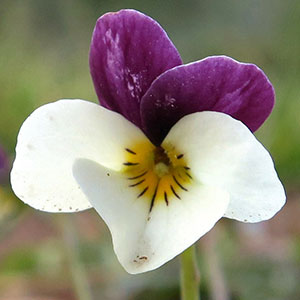Viola hallii
Viola clauseniana
Hall's violet, Oregon violet, wild pansy
Clausen's violet
1–3, decumbent or ascending to erect, ca. 1/2 subterranean, glabrous, clustered on single, short, vertical, deep-seated caudex.
basal and cauline;
basal: 1–4, palmately compound, ± 2-ternate or 3-ternate, leaflets 3;
stipules adnate to petiole, forming 2 linear-lanceolate wings, unlobed, margins entire, apex of each wing free, acute;
petiole 5–8 cm, glabrous;
blade ovate to deltate, 2.8–6 × 2.6–6.5 cm, ± coriaceous, base tapered, ultimate lobes narrowly elliptic, lanceolate, or oblanceolate, 1–7 mm wide, margins entire, ciliate or eciliate, apex acute, mucronulate, surfaces glabrous;
cauline similar to basal except: stipules usually lanceolate, sometimes broadly ovate, ± leaflike, margins toothed;
petiole 1.3–6 cm;
blade 2–4.8 × 1.2–5.5 cm.
basal, 2–10, often prostrate, sometimes ascending;
stipules narrowly lanceolate, margins faintly glandular-toothed, apex acute or obtuse;
petiole 5–11 cm, glabrous;
blade unlobed, ± deltate, 3–5 × 4–5 cm, base ± truncate, margins serrate, ciliate or eciliate, apex obtuse, surfaces usually glabrous, sometimes sparsely pubescent abaxially.
2.5–11 cm, glabrous.
8–14 cm, glabrous.
sepals lanceolate to ovate, margins ciliate, auricles 0.5–1 mm;
petals: upper 2 almost black abaxially, dark reddish violet adaxially, lower 3 pale yellow, cream, or ± white, lateral 2 bearded, with deep yellow to orange patch basally, dark reddish violet-veined, lowest with deep yellow to orange patch basally, dark reddish violet-veined, 5–18 mm, spur yellow, gibbous, 0.5–2 mm;
style head bearded; cleistogamous flowers absent.
sepals lanceolate to ovate, margins eciliate or ciliate around auricles, auricles 1–2 mm;
petals light violet on both surfaces, lower 3 purple-veined, all beardless, lowest petal 8–20 mm, spur white, gibbous, 2–3 mm;
style head beardless; cleistogamous flowers on prostrate to ascending peduncles.
ellipsoid, 4–12 mm, glabrous.
oblong, 8–10 mm, glabrous.
light brown, shiny, 3.2–3.5 mm.
dark brown to black, 1.2–2 mm.
= 60, 72.
= 44.
Viola hallii
Viola clauseniana
Viola hallii was discovered on the grounds of Willamette University in Salem, Oregon, by Elihu Hall, a professor at that institution (V. B. Baird 1942). Leaves of V. hallii are similar to V. beckwithii.
(Discussion copyrighted by Flora of North America; reprinted with permission.)
Of conservation concern.
Viola clauseniana is endemic to Zion National Park, Washington County. M. S. Baker reported that its seeds were minutely roughed, a characteristic not recorded for other Viola species. Viola clauseniana was originally thought to be closely related to the acaulescent blue violets, most notably V. nephrophylla (S. L. Welsh et al. 1987; L. E. McKinney 1992). After contemplating the 2n = 44 chromosome count obtained by J. Clausen (1964), H. E. Ballard (pers. comm.) suggested that V. clauseniana might be more closely related with the stemless white violets (for example, V. blanda) than with V. nephrophylla. Viola clauseniana was considered a distinct species by N. H. Holmgren (2005d) and T. Marcussen and T. Karlsson (2010).
(Discussion copyrighted by Flora of North America; reprinted with permission.)


